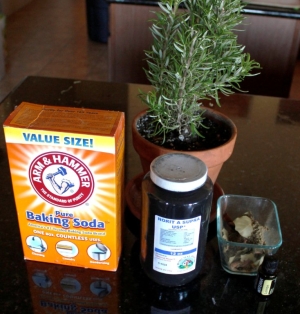Natural Year Challenge: Household - Month Nine
Clean Your Air
 Welcome to the ninth step in our Natural Year Challenge! Our journey toward healthier, less toxic living continues with a look at a vital component of our indoor environment: the air we breathe.
Welcome to the ninth step in our Natural Year Challenge! Our journey toward healthier, less toxic living continues with a look at a vital component of our indoor environment: the air we breathe.
Air fresheners, in synthetic form, do little to freshen the air and do much to hamper our health. Their primary function of masking odors is accomplished either by deadening our nerves with a toxic chemical or interfering with our sense of smell by coating our nasal passages with an oil film.
Thankfully, there are numerous natural options that do more than mask odors! In many cases, these alternatives actually reduce the number of toxins in the air, which results in improved energy, mental stamina, and overall health. One option is to purchase an air purifier (see these product comparisons from Allergy Buyers Club). Other options include the following five categories of natural air fresheners for the home or office.
- Odor Eliminators.
- Baking soda. Neutralizes odors by turning them into inert crystalline salts over time. Keep an open box of baking soda in areas where odor management is desirable. Add several drops of essential oil for added benefit. Or combine 1/2 c. baking soda and 4 c. water and simmer on the stove or in a crock pot to help absorb odors. Always check for water evaporation and refill as needed.
- Charcoal. Charcoal's large surface area and highly developed pore structure make it an excellent choice for neutralizing odors. BuyActivatedCharcoal.com offers an all-natural charcoal derived from coconut.
- Zeolite. This is a microporous mineral encompassing many times its weight in odors or moisture. It is an excellent option for mildew smells. (Check for hidden moisture before treating the odor, as a toxic mold problem may exist.) Refreshingly Free offers several zeolite odor-control products.
- Plants.
The purple waffle plant, English ivy, asparagus fern, areca palm, and purple heart are examples of plants that help purify your environment's air. See this article for more.
- Diffuser.
Pure essential oils offer numerous health-boosting benefits, including purifying the air. Diffusers offer a way to put essential oils into the air. There are four types of diffusers: nebulizing diffusers, humidifying diffusers, evaporative diffusers, and heat diffusers. Abundant Health offers this informative explanation of each type. Air purifying essential oils include tea tree oil, lemongrass, peppermint, and eucalyptus. Abundant Health and Diffuser World both offer several excellent diffuser options.
- Deodorizing Spray.
With an empty spray bottle, you can easily make your own air freshener by adding several drops of your favorite essential oil to 1 c. distilled water. Add 1-2 tbsp. plain vodka to help thin out the oil and retain its scent.
- Simmering Potpourri.
The possibilities are endless for this air freshener. Make your own potpourri using favorite herbs, spices, flower petals, and essential oil. Place 1/2 c. of mixture in 4 c. water and simmer on your stove for hours of enjoyment. Always check for water evaporation and refill as needed. 8-10 drops of essential oil can be used in place of potpourri. Your favorite combination can also be simmered in a crock pot. Keep the lid off and check for evaporation.
Country Spice Potpourri Recipe
- 1 c. dried apples
- 1 c. bay leaves
- 1/2 c. unpeeled ginger
- 1/2 c. whole cloves
- 6 cinnamon sticks
Combine in glass jar. Stir. Cap the jar and leave for 3-4 weeks. Shake several times per week.
In the following video, Andrea demonstrates
several of the natural air-freshening options mentioned above.

